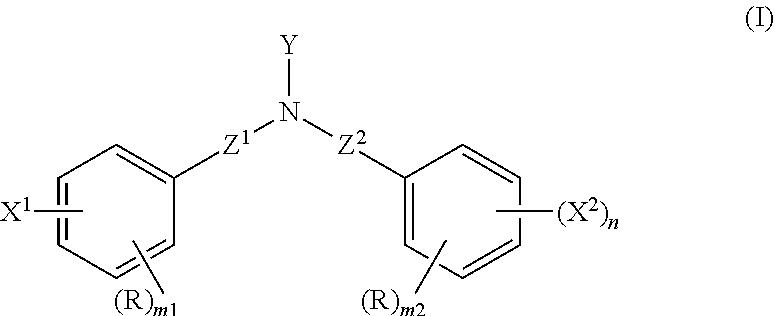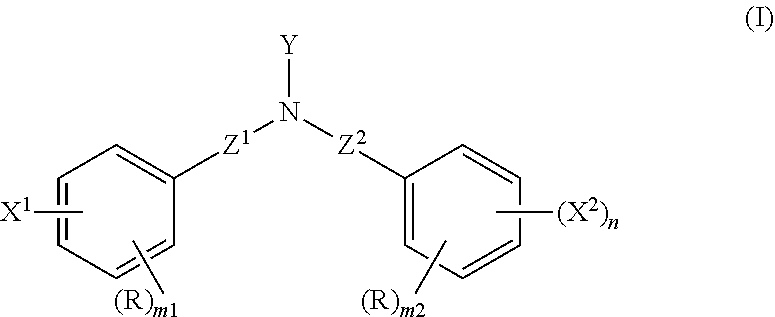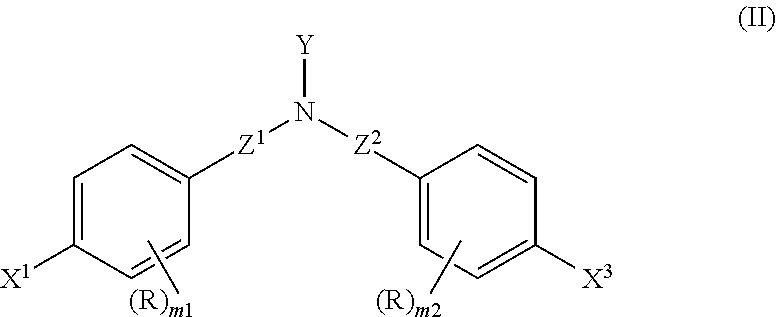Adhesive composition
- Summary
- Abstract
- Description
- Claims
- Application Information
AI Technical Summary
Benefits of technology
Problems solved by technology
Method used
Image
Examples
synthesis example 1
Synthesis of N,N-bis(4-(1,1,3,3-tetramethylbutyl)phenyl)acrylamide (Compound A)
[0106]
[0107]Bis[4-(1,1,3,3-tetramethylbutyl)phenyl]amine (NOCRAC AD-F manufactured by Ouchi Shinko Chemical Industrial Co., Ltd., containing a trace amount of N-phenyl-4-(1,1,3,3-tetramethylbutyl)benzenamine) (50.00 g, 0.127 mol), N,N-dimethylaniline (46.17 g, 0.381 mol), and 477 mL of super-dehydrated dichloromethane were added to a 1 L four-necked flask purged with nitrogen, and the mixture was stirred until the components were dissolved uniformly. Then, the reaction solution was cooled to 0° C. or less in an ice / ethanol bath, acrylic acid chloride (22.99 g, 0.254 mol) was slowly dropped, and the mixture was stirred for 30 minutes. Then, the temperature of the reaction liquid was increased to room temperature, and the reaction was performed for 24 hours. After the completion of the reaction, the solvent was distilled off by an evaporator, and the crude product was dissolved in 250 mL of ethyl acetate. T...
synthesis example 2
[0110]Making of poly{N,N-bis(4-(1,1,3,3-tetramethylbutyl)phenyl)acrylamide} (Compound A-1)
[0111]10.00 g of N,N-bis(4-(1,1,3,3-tetramethylbutyl)phenyl)acrylamide obtained in Synthesis Example 1 and 0.030 g of azobisisobutyronitrile were added to a 200 mL two-neck flask. A stirring bar was placed, and the Schlenk tube was sealed with a three-way cock, and then a gas sampling bag containing nitrogen was placed. The container was degassed by a vacuum pump, and then purged with nitrogen. Then, 40.00 mL of deoxygenated toluene was added, and the mixture was heated in an oil bath at 65° C. for 24 hours, resulting in a radical polymerization reaction. After the completion of the reaction, the reaction liquid was added to methanol for reprecipitation. From GPC, the number average molecular weight (Mn) of the obtained polymer was 23,700, and the molecular weight distribution (PDI) was 1.88.
synthesis examples 3 to 7
[0112]As in Synthesis Example 2, poly{N,N-bis(4-(1,1,3,3-tetramethylbutyl)phenyl)acrylamide} of different molecular weights (Compounds A-2 to A-6) were made by thermal radical polymerization reaction using azobisisobutyronitrile (AIBN) as an initiator. Table 1 shows the reaction conditions and the yields, number average molecular weight, and molecular weight distribution of the obtained high molecular weight compounds.
TABLE 1Number average Molecular Compound Amount ofAIBN Yieldmolecular weightweightCompoundA(g)toluene (g)(g)(%)MndistributionA-11034.670.0303223,7001.88A-23045.000.0776119,1281.71A-33045.000.0979514,3161.89A-43045.000.1939513,3271.53A-53070.000.2429811,1781.42A-63070.000.386976,3561.56
(Solubility Test)
[0113]The solubility of Compounds A-1 to A-6 and poly(N,N-diphenylacrylamide) (Compound B) in various reagents was investigated. With 0.7 g of a reagent was mixed 0.3 g each of Compounds A-1 to A-6 and Compound B, and the mixture was stirred with a stirring bar for 20 min...
PUM
| Property | Measurement | Unit |
|---|---|---|
| Fraction | aaaaa | aaaaa |
| Fraction | aaaaa | aaaaa |
| Fraction | aaaaa | aaaaa |
Abstract
Description
Claims
Application Information
 Login to View More
Login to View More - R&D
- Intellectual Property
- Life Sciences
- Materials
- Tech Scout
- Unparalleled Data Quality
- Higher Quality Content
- 60% Fewer Hallucinations
Browse by: Latest US Patents, China's latest patents, Technical Efficacy Thesaurus, Application Domain, Technology Topic, Popular Technical Reports.
© 2025 PatSnap. All rights reserved.Legal|Privacy policy|Modern Slavery Act Transparency Statement|Sitemap|About US| Contact US: help@patsnap.com



